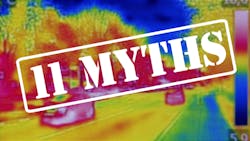11 Myths About Thermal Imaging for Cars (Download)
Public concern over rising pedestrian deaths at night has focused the attention of automotive manufacturers and regulators on the failure of automotive pedestrian automatic emergency braking (PAEB) systems to work when the sun goes down.
During the day, the current combination of video cameras and radar works well. However, at night when the cameras can’t see, radar alone has insufficient spatial resolution to locate and identify pedestrians. LiDAR has been proposed as an adjunct, but its low repetition rates and difficulties seeing through fog and rain can limit the effectiveness, and it can’t be used for object classification.
Decades of experience in surveillance and defense have shown that thermal imaging in the infrared should be able to address all of the current system shortcomings. Until now, though, the cost, bulk, complexity, and operating constraints of current cameras has prevented adoption of this technology in automobiles. We’re here to shatter those myths.
